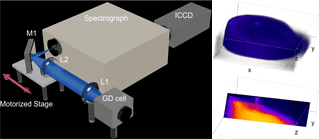One area in which we are particularly interested is chemical imaging: the ability to obtain spatially resolved chemical landscapes is critical for understanding the mechanisms in biological systems and guiding the development of novel materials.
 One of the challenges faced in chemical imaging is obtaining elemental maps of large areas in a fast manner such that it becomes practical for routine analysis. We are overcoming this challenge by developing a glow discharge optical emission spectroscopy elemental mapping technique (i). Another area in which we are interested is mass spectrometry: the ability to obtain elemental, structural, molecular, and isotopic information is also critical for many relevant samples. One of the challenges in mass spectrometry is the sample preparation that allows the introduction of solid samples into the mass spectrometer and is typically the bottleneck in the analysis. We are overcoming this challenge by developing ambient ionization techniques (ii). An alternative way we are overcoming sample throughput limitations in chemical analysis is through development of compressed sensing schemes. CS hinges on group incoherent sampling and sparsity to allow performing compression during acquisition (iii). Additionally, most of our chemical analysis techniques are based on plasmas (partially ionized gases) with novel geometries and modes of operation. Here, we bridge the gap between instrument and application development by improving the understanding of the plasma underlying mechanisms that will ultimately lead to enhanced analytical performance (iv).
One of the challenges faced in chemical imaging is obtaining elemental maps of large areas in a fast manner such that it becomes practical for routine analysis. We are overcoming this challenge by developing a glow discharge optical emission spectroscopy elemental mapping technique (i). Another area in which we are interested is mass spectrometry: the ability to obtain elemental, structural, molecular, and isotopic information is also critical for many relevant samples. One of the challenges in mass spectrometry is the sample preparation that allows the introduction of solid samples into the mass spectrometer and is typically the bottleneck in the analysis. We are overcoming this challenge by developing ambient ionization techniques (ii). An alternative way we are overcoming sample throughput limitations in chemical analysis is through development of compressed sensing schemes. CS hinges on group incoherent sampling and sparsity to allow performing compression during acquisition (iii). Additionally, most of our chemical analysis techniques are based on plasmas (partially ionized gases) with novel geometries and modes of operation. Here, we bridge the gap between instrument and application development by improving the understanding of the plasma underlying mechanisms that will ultimately lead to enhanced analytical performance (iv).
GDOES Elemental Mapping 
Glow discharge optical emission spectroscopy (GDOES) is a cathodic sputtering technique that has gained wide interest because it allows quantitative elemental depth profiling from surfaces (with nm resolution) with high sample throughput. However, the lateral resolution in GDOES is typically limited by the sputtered area (mm). Very recent developments showed the possibility to obtain laterally resolved information from within the sputtered area by operating the GD in pulsed power mode, which opened the possibility to map large areas (100 cm2) simultaneously in a matter of seconds. This research avenue will serve to enable fast chemical imaging and improve the understanding of glow discharge mechanisms.
Ambient Desorption/Ionization Mass Spectrometry 
Ambient ionization mass spectrometry has gone through a spectacular growth in a short amount of time because ADI sources enable desorption, extraction, ionization with little-to-no sample preparation. There has been a multitude of techniques developed along with a myriad of proof-of-principle applications. Although application development is still growing, there is a need to further understand the fundamental processes and overcome quantitation problems. This research avenue will focus on studying the mechanisms and matrix effects encountered in ambient ionization while developing new applications, such as monitoring medication metabolites.
 Ambient Desorption/Ionization Ion Mobility Spectrometry
Ambient Desorption/Ionization Ion Mobility Spectrometry
Drift Tube Ion Mobility Spectrometry (DTIMS) is an ion separation technique at atmospheric pressure where ions are separated based on their individual mobilities as they pass through the drift gas under a uniform electric field. DTIMS features excellent detection limits, fast responses, low costs, and portability which allows identification and quantification of trace substances like pharmaceuticals, explosives and environmental toxins. Here,we coupled Flowing Atmospheric-Pressure Afterglow Discharge as an ambient desorption/ionization source to a stand alone DTIMS for the first time.
Compressed sensing hyperspectral imaging 
![]()
Hyperspectral imaging allows obtaining a vast amount of chemical information by collecting a spectra for every pixel in a picture of a sample. Nevertheless, typical techniques require array detectors that can be very expensive or pixel-to-pixel rastering approaches that are highly time-consuming. Further, the acquired image files are compressed to keep data manageable, which can be achieved without loss of critical information, thus showing the sparsity of the data. A fairly recent paradigm in sampling, compressed sensing (CS), allows performing compression during acquisition which results in a more efficient use of experimental resources. As such, CS systems can be much faster, cost-effective, or even provide better resolution or throughput. In this project, CS approaches are being designed and implemented to harness the above mentioned advantages for chemical imaging purposes.
Plasma fundamentals studies 

The use of plasmas (or ionized gases) for chemical analysis is very extensive. Plasmas, such as inductively coupled plasmas, glow discharges, and dielectric barrier discharges among others, can be used in tandem with optical spectroscopy or mass spectrometry to obtain elemental, structural, molecular, and/or isotopic information. Nevertheless, the underlying mechanisms of how the sample interacts with the plasma or how the analytical signal is developed within a plasma are not completely understood. This issue is even more apparent in chemical analysis techniques that use novel plasma geometries or apply plasmas in a novel manner, for example in ambient desorption/ionization sources for mass spectrometry. This project aims to improve the understanding of such underlying mechanisms through a variety of techniques including optical emission spectrometry, mass spectrometry, laser scattering, electro-optic effect, etc.
